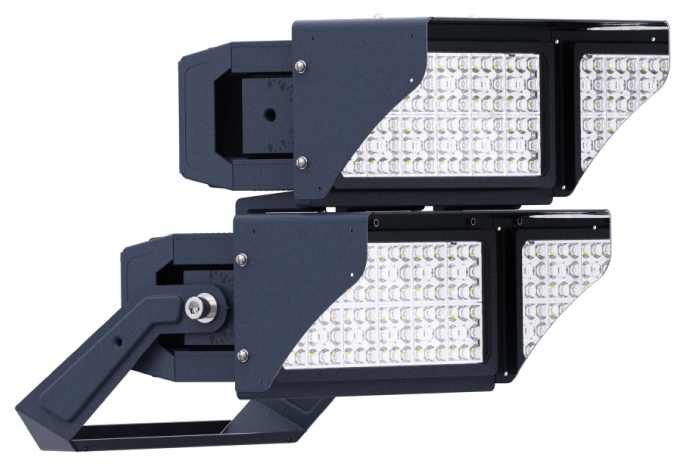Sport Lighting Quality
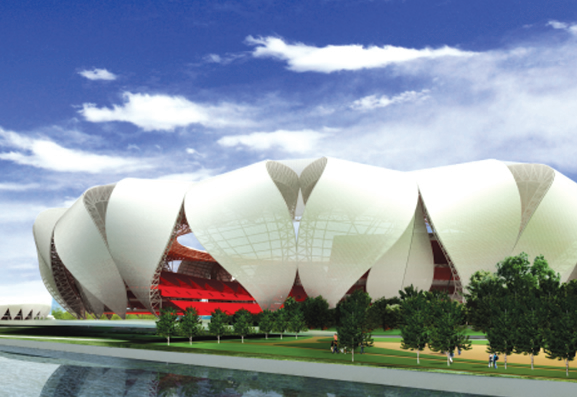
Directory:
1. The impact of the lamp's light distribution curve on sport lighting quality
2. The Impact of Horse Runway Position on Sport Lighting Quality
3. Conclusion
Lighting plays a crucial role in effectively showcasing the functions of a gymnasium. A well-thought-out lighting design must take into account various factors, ensuring that aspects such as color temperature, illumination, glare, and color rendering index adhere to established standards. Additionally, the lamp's light distribution curve and the positioning of the horseway significantly influence the overall lighting quality. This study employs DIAlux simulation software to create a model of a gymnasium, examining and comparing how the lamp's light distribution curve, the installation position of the horseway, and the aiming angle of the lamp impact the sport lighting quality, ultimately identifying the optimal lighting design.
1. The impact of the lamp's light distribution curve on sport lighting quality
To investigate how the light distribution curve affects the sport lighting quality, the author utilized DIAlux software, focusing on a basketball hall as a case study. The analysis varied the projection distance and light distribution curve while keeping the light source and projection angle constant. The study evaluates lighting metrics across different projection distances and light distribution curves to provide valuable data for selecting and configuring lamps.
1.1 Lighting fixture configuration
Six different light distribution curves were established, with ten projection distances set at 15 m, 20 m, 25 m, 30 m, 35 m, 40 m, 45 m, 50 m, 55 m, and 60 m for each curve. To ensure the simulation's accuracy, the actual dimensions of the basketball hall were used, measuring 28 m × 15 m; the lighting fixtures were positioned at a 45° angle, and the camera was placed 25 m from the centerline of the venue at a height of 10.5 m.
1.2 Lighting fixture selection
The experiment involved six types of lighting fixtures, all sharing the same power, color rendering index, and maintenance coefficient, with the only variation being the light distribution curve. The light distribution curves for the fixtures are illustrated in Figure 1.
Fig. 1 Luminaire light distribution curve(unit :cd)

1.3 Simulation Outcomes
The software DIALux 4.13 was utilized to simulate 10 sets of projection distances for each light distribution curve. The simulation data was then organized, and the findings are presented in Table 1.
Tab.1 Luminaire simulation data

1.4 Data Analysis
The average horizontal illuminance must exceed 0.5 times the average horizontal illuminance at a projection distance of 15 m to meet the requirements. Similarly, the average vertical illuminance must also exceed 0.5 times the average vertical illuminance at the same distance. Additionally, the horizontal illuminance uniformity should be greater than 0.5. and the vertical illuminance uniformity should be greater than 0.4.
a. The average illuminance and uniformity for lamp A1 at various projection distances are as follows:
① At projection distances of 15 m, 20 m, 25 m, 30 m, 35 m, 40 m, 45 m, 50 m, and 55 m, both horizontal and vertical illuminance are acceptable, but the uniformity for both is relatively poor.
② At a projection distance of 60 m, the uniformity for both horizontal and vertical illuminance meets the required standards, and the average illuminance values are acceptable.
b. The average illuminance and uniformity for lamp A2 at different projection distances are as follows:
① At projection distances of 15 m, 20 m, 25 m, 30 m, 35 m, 40 m, and 45 m, the horizontal and vertical illuminance are acceptable, but their uniformity is poor.
② At projection distances of 50 m and 55 m, the uniformity for both horizontal and vertical illuminance meets the required standards, and the illuminance values are acceptable.
③ At a projection distance of 60 m, the uniformity for both horizontal and vertical illuminance is excellent, but the illuminance values are significantly lower.
c. The average illuminance and uniformity of lamp A3 at various projection distances are as follows:
① At projection distances of 15 m, 20 m, 25 m, 30 m, and 35 m, both horizontal and vertical illuminance levels are acceptable, but their uniformity is lacking;
② At distances between 40 m and 50 m, the uniformity of horizontal and vertical illuminance meets the required standards, and the illuminance levels are acceptable;
③ At 55 m and 60 m, the uniformity of horizontal and vertical illuminance is excellent, although the average values for both are significantly lower.
d. The average illuminance and uniformity of lamp A4 at different projection distances are as follows:
① At 15 m, 20 m, and 25 m, the average horizontal and vertical illuminance are acceptable, but the uniformity for both is relatively poor;
② At 30 m, 35 m, and 40 m, the uniformity of horizontal and vertical illuminance meets the necessary requirements, and the illuminance levels are acceptable;
③ At 45 m, 50 m, 55 m, and 60 m, the uniformity of both horizontal and vertical illuminance is very good, but the average values for both are significantly reduced.
e. The average illuminance and uniformity of lamp A5 at various projection distances are as follows:
① At 15 m and 20 m, the horizontal and average vertical illuminance are acceptable, but their uniformity is relatively poor;
② At 25 m, 30 m, 35 m, and 40 m, the uniformity of horizontal and vertical illuminance meets the required standards, and the illuminance levels are acceptable;
③ At 45 m, 50 m, 55 m, and 60 m, the uniformity of both horizontal and vertical illuminance is very good, but the average values for both are significantly lower.
f. The average illuminance and uniformity of lamp A6 at various projection distances are detailed below:
① At a projection distance of 15 m, both the horizontal and average vertical illuminance are acceptable; however, the uniformity of horizontal and vertical illuminance is relatively low.
② At projection distances of 20 m, 25 m, and 30 m, the uniformity of both horizontal and vertical illuminance meets the required standards, and the horizontal and average vertical illuminance are acceptable.
③ At projection distances of 35 m, 40 m, 45 m, 50 m, 55 m, and 60 m, the uniformity of horizontal and vertical illuminance is excellent, but the average values for both horizontal and vertical illuminance are significantly lower.
Based on this information, suitable installation heights for lamps with different light distribution patterns have been compiled in Table 2.
Tab. 2 Applicable installation height of luminaire with different light distribution curves
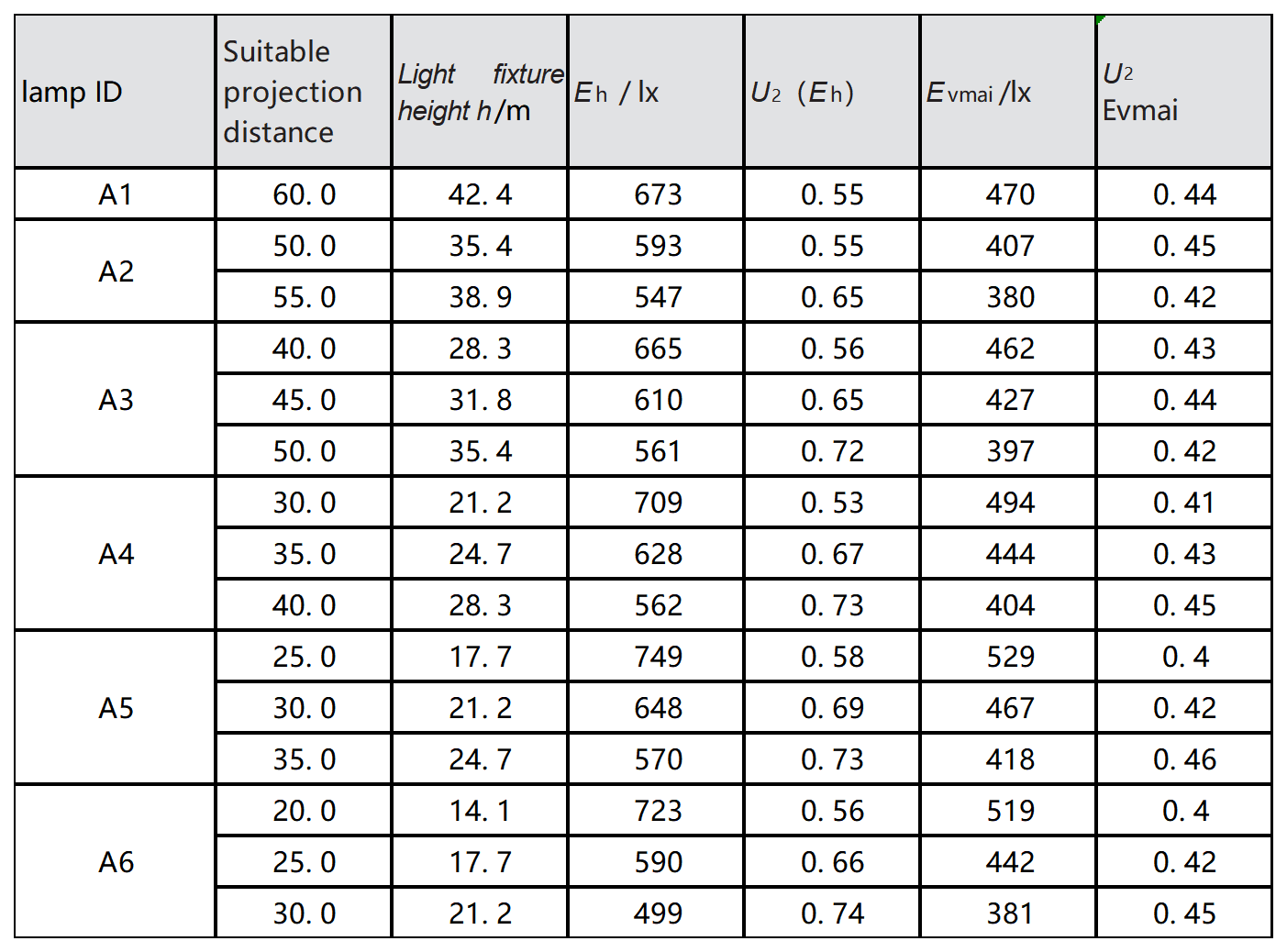
2. The Impact of Horse Runway Position on Sport Lighting Quality
This paper examines how the placement of the horse runway affects lighting quality by utilizing DIAlux software to analyze variables such as the distance from the runway's horizontal projection to the near edge line and the height of the runway above the ground. The lamp's light source, projection angle, distance, and light distribution curve are all measured quantitatively. The study evaluates lighting metrics based on varying distances of the runway's horizontal projection from the venue's center and its height from the ground, offering valuable data for determining the optimal runway position.
2.1 Installation Parameters
This analysis focuses solely on the installation of a single horse runway. An installation diagram for the lamps associated with this runway is presented in Figure 2. To maintain a glare value below 30 in the gymnasium, the angle φ between the luminaire's projection onto the venue and the far edge must be at least 25°. Additionally, to ensure that the ratio of horizontal to vertical illumination uniformity does not exceed 2. the angle θ between the luminaire's projection onto the venue and the near edge should not exceed 65°.
Fig. 2 Installation position of luminare in single catwalk
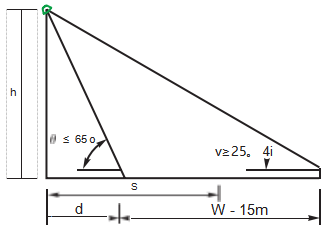
To ensure the accuracy of the simulation data, the actual dimensions of the basketball hall, which are 28 m by 15 m, were chosen as the venue size. The light source is positioned at the center of one-quarter of the venue (illustrated in Figure 3), and the camera is placed 25 m away from the venue's center line, at a height of 10.5 m.
The height of the horse trail above the ground is set at h = 16.5 m. The distance S between the horizontal projection of the horse trail and the venue's center point ranges from 7.5 m to 47.5 m, comprising a total of 41 groups with 1 m intervals. Only the distances between 15.5 m and 27.5 m from the horizontal projection of the horse trail to the venue's center point satisfied the criteria of φ ≥ 25° and θ ≤ 65°, resulting in 13 groups. Detailed specifications are provided in Table 3.
Tab.3 Parameters conforming to the setting conditions if “S ”is variable and h = 16. 5 m
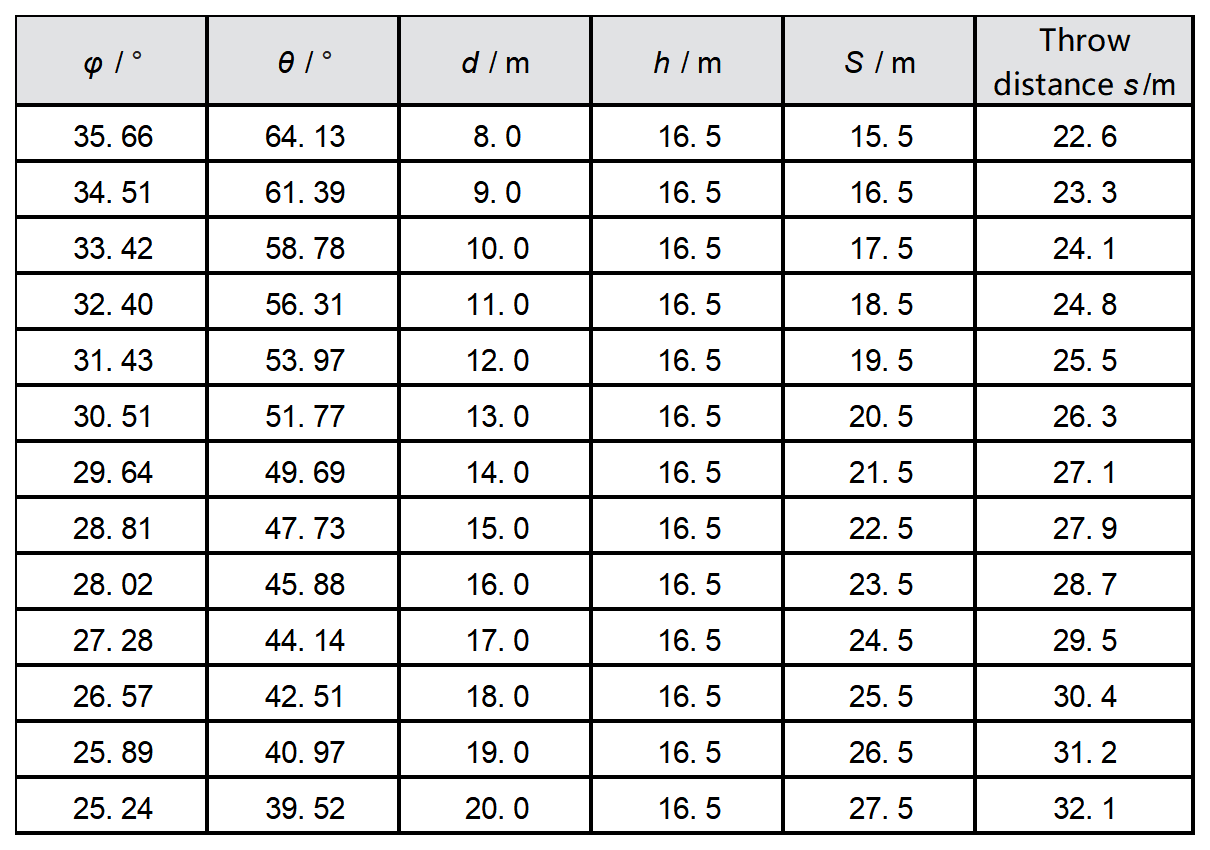
The horizontal projection of the horse trail is S = 22.5 m from the center of the venue. The height h of the breeze trail ranges from 10 to 40 m above the ground, consisting of a total of 31 groups with 1 m intervals. However, only the height h of the breeze trail between 14 and 32 m meets the criteria of φ ≥ 25° and θ ≤ 65°, with detailed parameters provided in Table 4.
Tab.4 Parameters conforming to the setting conditions if “h ”is variable and S = 22. 5 m
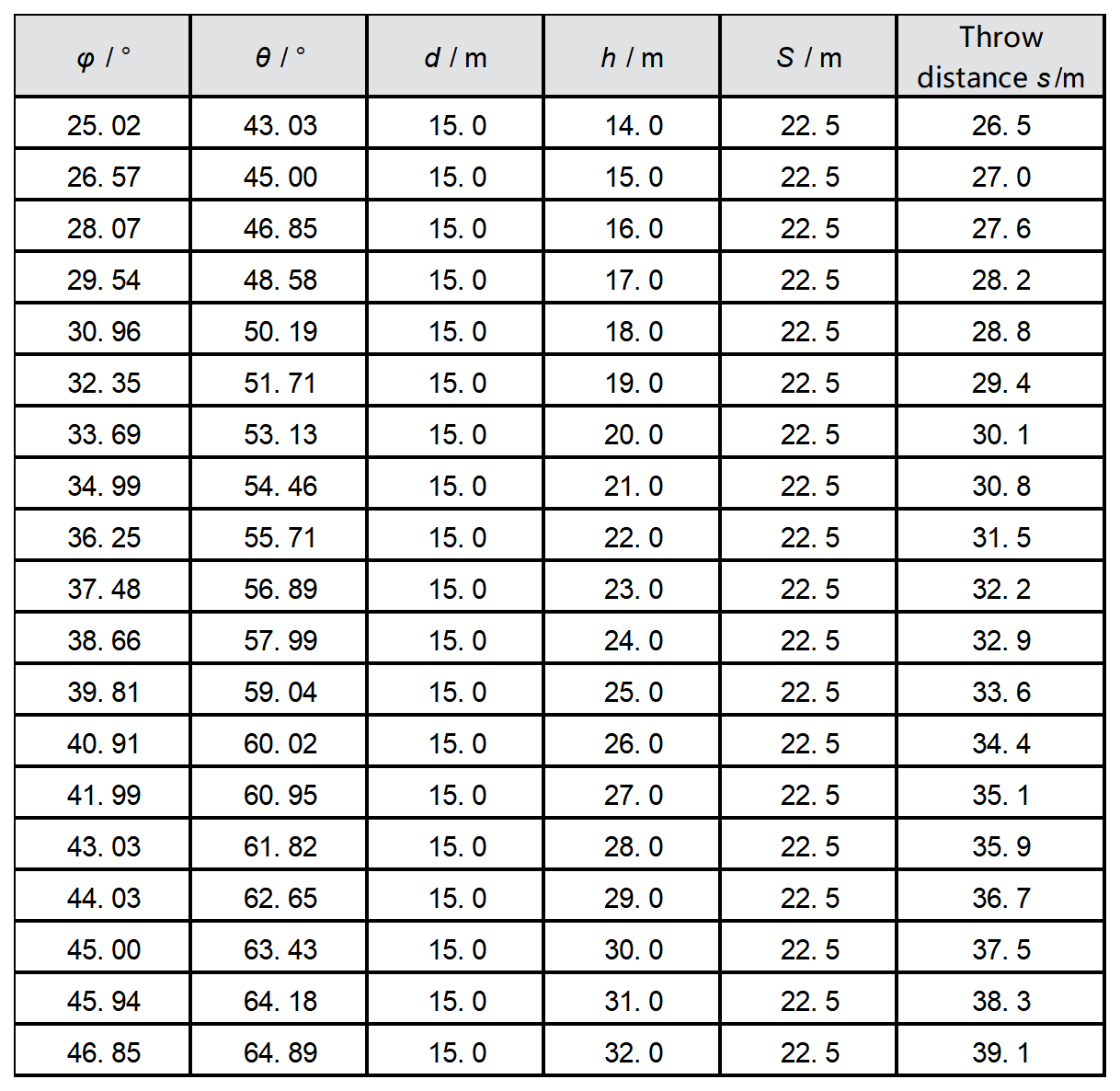
2.2 Simulation Outcomes
a. Utilizing DIALux 4.13 software, 13 data sets were simulated for various distances between the horizontal projections of the catwalk and the center point of the field. The simulation data was then organized, and the results are presented in Table 5.
Tab.5 Simulation data of distance between different horizontal projections of catwalks and the center point of field
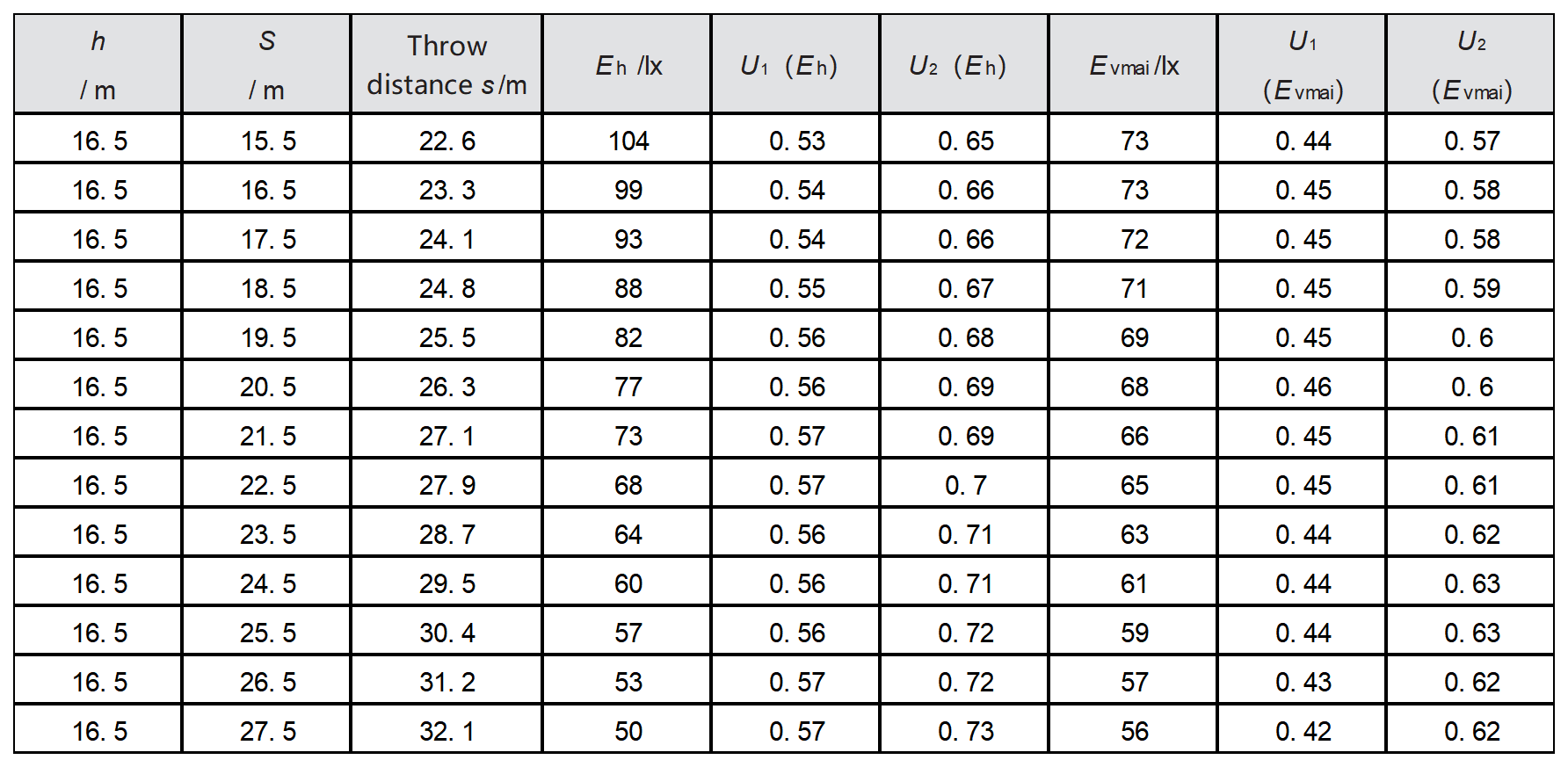
b. Utilizing DIALux 4.13 software, 19 sets of data were generated for various heights from the catwalk to the ground, and the simulation results were organized. The findings are presented in Table 6.
Tab.6 Simulation data on different catwalks heights from the ground
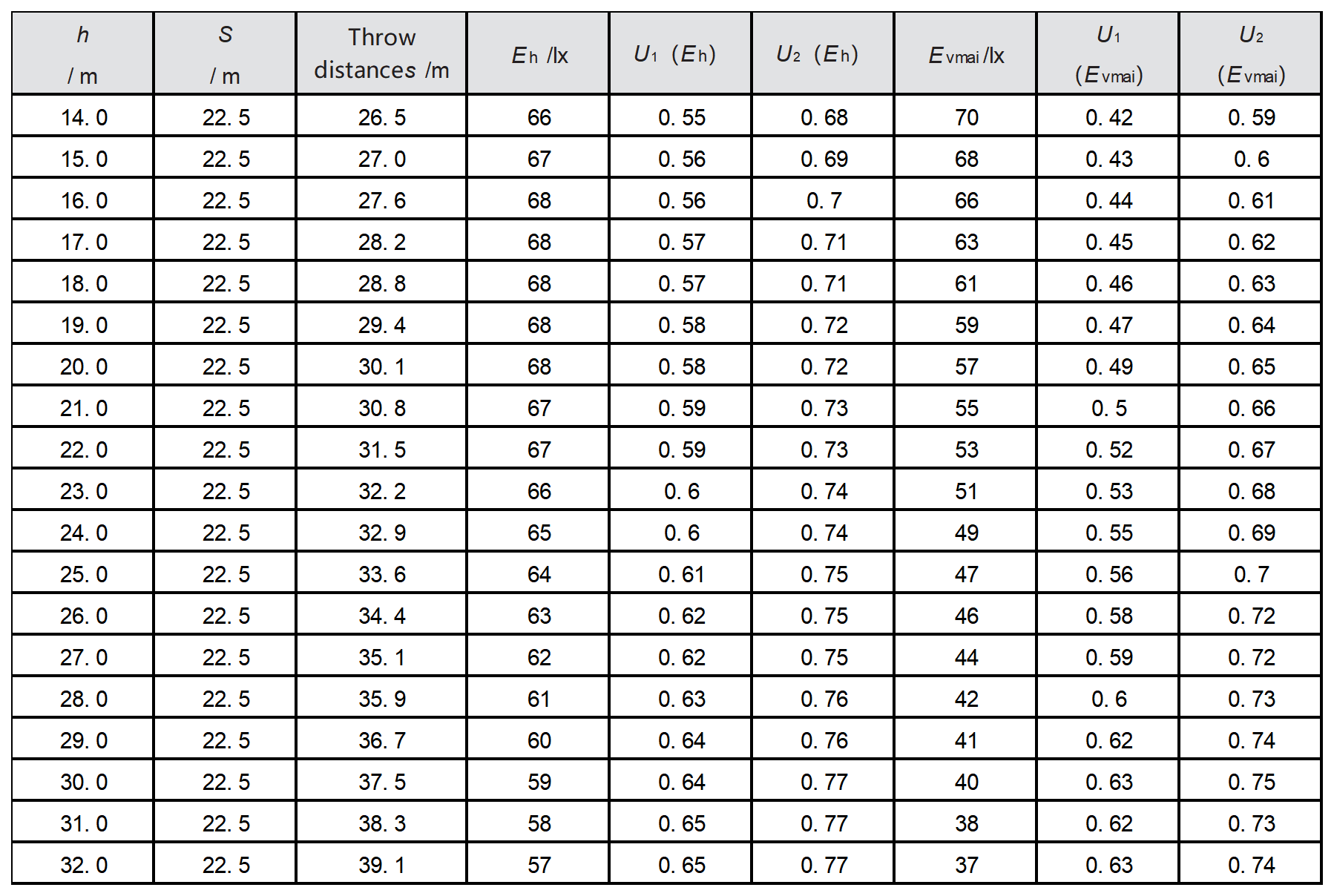
2.3 Data Analysis
a. As the distance S between the horizontal projection of the catwalk and the center of the field increases, the uniformity of illumination improves.
b. An increase in the distance S from the horizontal projection of the catwalk to the center of the field results in greater fluctuations in horizontal illuminance compared to vertical illuminance.
c. A higher height h of the catwalk above the ground leads to a lower average illuminance, which is greater than the horizontal illuminance.
d. As the height h of the catwalk from the ground increases, the fluctuations in vertical illuminance become more pronounced than those in horizontal illuminance.
3. Conclusion
a. The projection distance is inversely related to both horizontal and vertical illuminance, while it is directly related to uniformity.
b. Lamps with a narrow light distribution curve are best suited for long-distance lighting applications. Using these lamps in close-range settings results in poor illumination uniformity, whereas wide light distribution curve lamps are ideal for close-range lighting. However, using wide distribution lamps in long-distance scenarios leads to significant illumination loss.
c. Analysis of simulation data indicates that the choice of light distribution curve is crucial in the design of sports venues, as it influences both lighting quality and the number of fixtures needed, as well as energy consumption. Designers should carefully select the light distribution curve based on the actual installation height of the lamps.
d. The distance S of the horizontal projection of the horse track from the center of the venue is inversely related to average illumination, while illumination uniformity is positively correlated with height; similarly, the height h of the horse track above the ground is inversely related to average illumination and positively correlated with illumination uniformity.
e. The distance S of the horizontal projection of the horse track from the center of the field has a more significant effect on horizontal illuminance than on vertical illuminance, while the height h of the horse track from the ground has a greater impact on vertical illuminance compared to horizontal illuminance.
4. Related Product
